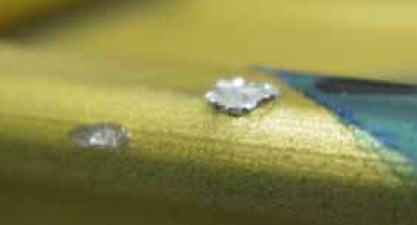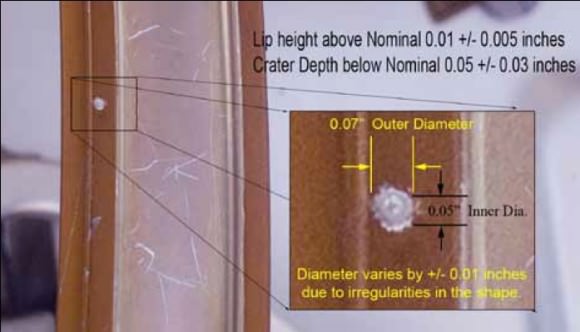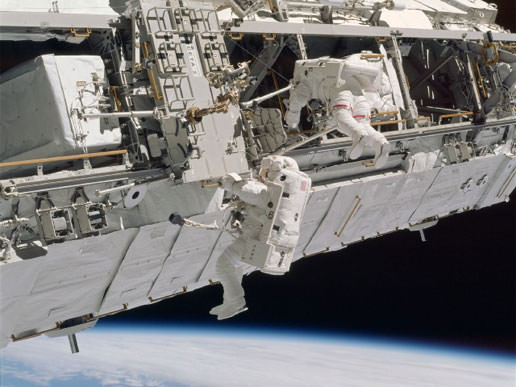Our very own International Space Station is in the cosmic crosshairs.
As cosmonauts are to begin Extra Vehicular Activity (EVA) this morning to perform routine maintenance, an article reminding us of the hazards of such activity came to us via NASA’s Orbital Debris Quarterly Newsletter.
The problem is Micrometeoroid and Orbital Debris (MMOD) impacts. These are nothing new. Pits and tiny cratering has been observed during post-flight inspections of space shuttle orbiters. But this is the first time we’d seen talk of damage caused by tiny impacts on the exterior of the International Space Station.
The handrails are a particularly sensitive area of concern.
The study examined damage incurred on handrails exposed to the environment of space for years on end. These present a hazard to spacewalking astronauts who rely on the handles to move about. These craters often become spalled, presenting a sharp metal rim raised from the surface of the handle.

Of course, these razor sharp rims present a problem, especially to space suit gloves. One 34.8 centimeter long handrail returned on the final Space Shuttle mission STS-135 had six impact craters along its length. The handrail had been in service and exposed to the vacuum of space for 8.7 years.
Craters as large as 1.85 millimetres (mm) in diameter with raised lips of 0.33mm have been observed on post-inspection. In studies conducted by NASA engineers, craters with lip heights as little as 0.25mm have been sufficient to snag and tear spacesuit gloves.
There have also been reported incidents of glove tears during EVAs conducted from the ISS over the years. For example, the report cites a tear noticed by astronaut Rick Mastracchio during STS-118 that cut the EVA short.

To protect astronauts and cosmonauts during EVAs, the following measures have been instituted:
– Toughening space suit gloves by adding reinforcement to areas exposed to potential MMOD damage.
– Monitoring and analyzing MMOD impacts along handrails and maintaining a database of problem areas.
– Equipping spacewalkers with the ability to cover and/or repair hazardous MMOD areas during spacewalks.
The studies were carried out by the Johnson Space Center Hypervelocity Impact Technology Group in conjunction with a test facility at White Sands, New Mexico. Astronaut Rick Mastracchio can also be seen talking about the hazards of spacewalking on this video.
Today’s 6 hour EVA by cosmonauts Vinogradov & Romanenko begins at 14:06 UT 10:06AM EDT.
This will be the 32nd Russian EVA from the International Space Station and will use the Pirs hatch on Zvezda.
Tasks include retrieving and installing experiment packages and replacing a defective retro-reflector device on the station’s exterior. The device is a navigational aid necessary for the Albert Einstein ATV-4 mission headed to the ISS on June 5th.
Progress 51P is also scheduled to launch towards the ISS next week on April 24 for docking on April 26th.
Debris in Low Earth Orbit is becoming an increasing concern. The Chinese anti-satellite test in 2007 and the collision of Kosmos 2251 and Iridium 33 in 2009 have increased hazards to the ISS. Many fear that a tipping point, known as an ablation cascade, could eventually occur with one collision showering LEO with debris that in turn trigger many more. The ISS was only finished in 2011, and it would be a tragic loss to see it abandoned due to a catastrophic collision only years after completion.
More than once, ISS crew members have sat out a debris conjunction that was too close to call in their Soyuz life boats, ready to evacuate the station if necessary. DAMs (Debris Avoidance Maneuvers) are now common for the ISS throughout the year.
Several ideas have been proposed to deal with space debris. In the past year, NanoSail-2D demonstrated the ability to deploy a solar sail from a satellite for reentry at the end of a spacecraft’s life span. Such technology may be standard equipment on future satellites.
Expect reentries to increase as we near the solar maximum for cycle #24 in late 2013 & early 2014. This occurs because the exosphere of Earth “puffs out” due to increased solar activity and increases drag on satellites in low Earth orbit.
All food for thought as we watch today’s EVA… space travel is never routine!
The April 2013 edition of the Orbital Debris Quarterly News is available for free online.


Will they use duct tape to cover the sharp areas?
The article didn’t make mention of how they could cover the hazard areas… but I do know they have duct tape available on the ISS. Also great for lunar rover fender repair and fitting square filters in round holes!
Forgot about the lunar rover. I was trying to be funny, but if duct tape sticks in a vacuum it may work.
What happens if one of the suits is hit by an object capable of creating a crater like that in the handrail?
I don’t think the video link is right — it’s showing something unrelated about exercise, with no mention of micrometeoroid impacts.
If you’re talking about the intro vid, its the live link to NASA TV from earlier today, when they were broadcasting the spacewalk live.